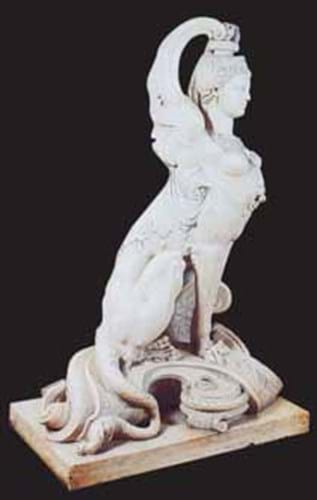
The castings were not by Rudier, with whom Maillol usually worked, but came from the little-known Rue de Belleville foundry of Florentin Godard (whose F. Godard signature is sometimes confused with the Fondrerie Godard owned by Désiré and Emile Godard). Maillol met Florentin Godard in 1908 and their fitful collaboration is not thought to have survived World War One, although they remained friends. Maillol's muse and legatee, Dina Vierny, suggested in the Binoche catalogue that the statuettes offered here may have been a gift from Maillol to Godard. All were described as unique castings and came from the estate of Renée Gilles, Florentin Godard's daughter-in-law.
Five of the eight sold, for a total of €294,000 (£196,000), led by the 1899 Baigneuse se Coiffant, 10 1/2in (27cm) high, at €82,000 (£54,665). The figure appears to have been a favourite of Maillol's; he kept a version at his home in Banyuls, and another in his studio near Paris. The other four statuettes to find takers were all female nudes in different poses; the unsold works were less typical of Maillol's oeuvre-two armless nudes and a Bergère (Shepherdess) in a transparent ankle-length robe.
Top price at the Binoche sale, though, was €190,000 (£126,665) for a small, early Picasso Cubist bronze Tête de Femme (1906-07), 4 3/4in (12cm) tall, and one of just three known castings, again by Florentin Godard. This, too, hailed from the Renée Gilles estate.
A pair of exuberant, white marble winged sphynxes signed Eugène Piat, 4ft 10in (1.48m) tall, dated 1873, sold for a quadruple-estimate €115,000 (£76,665) at Le Roux-Morel-Mathias (17.94-14.35% buyer's premium) on June 9. The sphynxes wore diadems, necklaces and earrings, had lion-heads on their chests, and were each perched on a base draped with a scroll featuring an unidentified coat of arms. Two similar sphynxes by Piat belong to the Fine Arts museum in Troyes - one in marble, the other in cast iron - along with a reduced version in plaster. The design is typical of Piat's mid-19th century eclecticism. He is perhaps best known for his clock, ewer and firedog designs, and his work featured at the Expositions Universelles of 1862, 1867 and 1889. Prosper Mérimée was one of his biggest fans.




